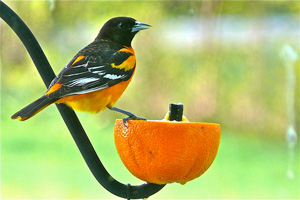by Liz Magnanti

Northern (Baltimore) Oriole (Icterus galbula). Photo courtesy Flickr: Larry & Teddy Page
The sounds of spring are in the air! Mornings are filled with the songs and chirps of birds as they try to attract mates and evenings bring the chorus of frogs and toads. Grosbeaks, orioles, warblers, hummingbirds and more have made their way back into the area where they are actively searching out food and nesting sites.
Rose-breasted grosbeaks are fairly large songbirds, with males being black and white with a bright red breast. Females are brown and white and look like oversized sparrows with a large beak. Grosbreaks are in the same family as cardinals and prefer similar food and feeders. An open feeder, such as a tray or hopper, is great for attracting grosbeaks. Load the feeder up with sunflower and safflower seeds for your best opportunity of getting grosbeaks at your feeder.
Orioles are gorgeous orange and black birds that migrate into the area in early May. They can be enticed to stay in your yard by feeding them their favorite foods—jelly, nectar and orange halves. The orioles’ favorite kind of jelly is grape, or birdberry jelly, which is a mix of grape and blackberry. Make sure the jelly you feed them has no artificial sweeteners or corn syrup. Oriole nectar can be purchased as a concentrate or a ready-to-use option. You can also make your own oriole nectar by combining one part sugar to five parts water. Make sure to boil the water before adding the sugar. Never add any dye to the nectar, as it can be harmful to the birds.
Hummingbirds are among the favorite birds to attract, and for good reason! These tiny birds migrate all the way here from Central and South America and arrive around Mother’s Day. Hummingbirds will make a tiny nest where they usually lay two eggs. They are fairly easy to attract, and will eagerly visit hummingbird feeders and tubular flowers. Like for the orioles, you can purchase nectar or make your own. The recipe for hummingbird nectar is one part sugar to four parts water. Hummingbirds also love native plants. Cardinal flower (Lobelia cardinalis), bee balm (Monarda didyma), wild columbine (Aquilegia canadensis), trumpet honeysuckle (Lonicera sempervirens), trumpet vine (Campsis radicans), and phlox (Phlox maculata) are just a few of their favorites. On the east coast we have only one species of hummingbird, the ruby-throated. These little birds are territorial and will actively defend food sources. The key to getting more hummingbirds in your yard is to put up multiple feeders (preferably out of sight of one another).
The flurry of bird activity has also brought in birds that can be less appealing to us. Grackles and starlings are dark colored birds that are known to decimate feeders and raid bird houses. Grackles are large birds with a black body and iridescent blue head. They migrate south in the winter but arrive back in the early spring. A common concern this time of year is the amount of seed these birds can eat. There are, however, ways to discourage grackles and starlings from coming to your feeders. The first is to switch your seed to safflower seed. Safflower is about the same size and shape as sunflower seed, but it is white in color. Safflower has a bitter taste that keeps away both blackbirds and squirrels. The best part though, is that most backyard birds love it. It is a favorite of cardinals and house finches and is also eaten by chickadees, titmice, nuthatches, blue jays, grosbeaks, finches and more. If blackbirds are raiding your suet feeder, switch to an upside-down suet feeder. These suet cages lie flat with a roof over them, to keep big birds from perching. To get to the suet, the bird must cling upside down on the feeder. This is an easy task for woodpeckers, nuthatches, and chickadees, but it is not possible for grackles. Another way to discourage grackles and blackbirds is to put out feeders with only small perches, or no perches at all. Grackles are large, require a lot of perching room, and prefer feeders with long perches and trays. Without the room to perch it is difficult for them to feed from bird feeders.
One of my favorite things to put out in the yard this time of year is a water feature. Not all birds will come to a feeder or bird house, but they all need water. A shallow source of water is great for small birds and warblers. Large, deep birdbaths may only attract big songbirds like robins, blue jays, and bluebirds that will sit in the bath to drink and bathe. Moving water sources attract birds better than standing water. Add a solar fountain or water wiggler to your birdbath to get even more birds flocking!
Liz Magnanti is manager of The Bird House in Brighton.
Views: 0





